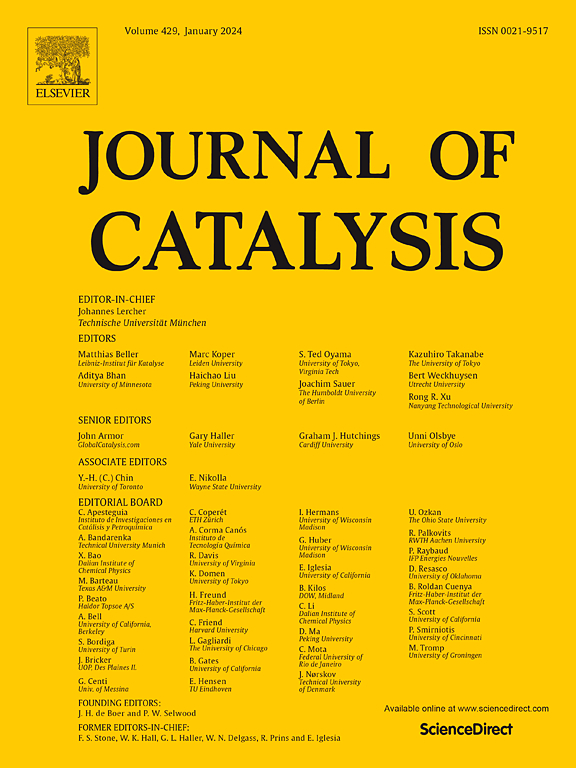Shape-selective zeolite catalysis for the tandem reaction of aromatic alcohol dehydration isomerization to internal alkene
IF 6.5
1区 化学
Q2 CHEMISTRY, PHYSICAL
引用次数: 0
Abstract
Zeolite-catalyzed dehydration of fatty alcohols to alkenes is an effective method for biomass conversion. This study extends the reaction to a tandem reaction process that catalyzes the dehydration isomerization of aromatic alcohols to generate internal alkene under mild conditions. By using three acidic zeolites (HZSM-5, USY, and HBeta) as catalysts, it was found that when using HZSM-5, the conversion rate of 3-phenylpropanol was 100% and the selectivity of 1-propenylbenzene was 99.4% at 150 ℃, the conversion rate and selectivity were significantly lower when using USY and HBeta as catalyst. Grand Canonical Monte Carlo (GCMC) was conducted to understand the product selectivity difference, and the results demonstrate that 3-phenylpropanol adsorbs within the HZSM-5 zeolite channels in a distinctive isolated molecular configuration. This adsorption mode exhibits favorable spatial isolation from neighboring catalytic sites, thereby significantly enhancing the monomolecular dehydration pathway and facilitating selective isomerization to yield 1-propenylbenzene. However, the excessive adsorption of 3-phenylpropanol in the large pores of USY and HBeta will facilitate the formation of ether through bimolecular dehydration. Density functional theory (DFT) calculations showed that the dehydration process of 3-phenylpropanol can be achieved through both concerted and stepwise pathways, respectively. While the selectivity between 1-propenylbenzene and 2-propenylbenzene was affected by the stabilization of HZSM-5 to reaction intermediates, proving shape-selective catalysis. In addition, our calculations found that 3-phenylpropanol can directly generate 1-propenylbenzene through a concerted dehydration isomerization (DHI) pathway in HZSM-5. The reaction kinetics using HZSM-5 catalysts show that the activation energy of the dehydration process was higher than that of the isomerization process, while the initial reaction rate showed the opposite result, which was consistent with the trend of the free energy barriers of the dehydration and isomerization processes in DFT calculations. In addition, the reaction orders of the dehydration and isomerization processes were studied separately, and the elementary reaction steps and rate-determining steps were proposed. The experimental results were consistent with the DFT calculations, and the use of HZSM-5 did not favor multi-molecular dehydration pathways.

选择性分子筛催化芳香醇脱水异构制内烯烃的串联反应
沸石催化脂肪醇脱水制烯烃是一种有效的生物质转化方法。本研究将该反应扩展为在温和条件下催化芳香醇脱水异构化生成内烯烃的串联反应过程。以3种酸性沸石(HZSM-5、USY和HBeta)为催化剂,发现在150℃条件下,HZSM-5对3-苯丙醇的转化率为100%,对1-丙烯苯的选择性为99.4%,而USY和HBeta为催化剂时,转化率和选择性明显降低。结果表明,3-苯丙醇在HZSM-5分子筛通道内的吸附具有独特的分离分子构型。这种吸附模式与邻近的催化位点具有良好的空间隔离性,从而显著增强了单分子脱水途径,促进了选择性异构化生成1-丙烯苯。然而,3-苯丙醇在USY和HBeta的大孔隙中过度吸附,将有利于通过双分子脱水形成醚。密度泛函理论(DFT)计算表明,3-苯丙醇的脱水过程可以分别通过协调和逐步两种途径实现。HZSM-5对反应中间体的稳定性影响了1-丙烯苯和2-丙烯苯的选择性,证明了其具有形状选择性催化作用。此外,我们的计算发现,在HZSM-5中,3-苯丙醇可以通过协同脱水异构化(DHI)途径直接生成1-丙烯苯。HZSM-5催化剂的反应动力学表明,脱水过程的活化能高于异构化过程的活化能,而初始反应速率则相反,这与DFT计算中脱水和异构化过程的自由能垒的趋势一致。并对脱水和异构化过程的反应顺序进行了研究,提出了基本反应步骤和定速步骤。实验结果与DFT计算结果一致,表明HZSM-5的使用不利于多分子脱水途径。
本文章由计算机程序翻译,如有差异,请以英文原文为准。
求助全文
约1分钟内获得全文
求助全文
来源期刊

Journal of Catalysis
工程技术-工程:化工
CiteScore
12.30
自引率
5.50%
发文量
447
审稿时长
31 days
期刊介绍:
The Journal of Catalysis publishes scholarly articles on both heterogeneous and homogeneous catalysis, covering a wide range of chemical transformations. These include various types of catalysis, such as those mediated by photons, plasmons, and electrons. The focus of the studies is to understand the relationship between catalytic function and the underlying chemical properties of surfaces and metal complexes.
The articles in the journal offer innovative concepts and explore the synthesis and kinetics of inorganic solids and homogeneous complexes. Furthermore, they discuss spectroscopic techniques for characterizing catalysts, investigate the interaction of probes and reacting species with catalysts, and employ theoretical methods.
The research presented in the journal should have direct relevance to the field of catalytic processes, addressing either fundamental aspects or applications of catalysis.
 求助内容:
求助内容: 应助结果提醒方式:
应助结果提醒方式:


